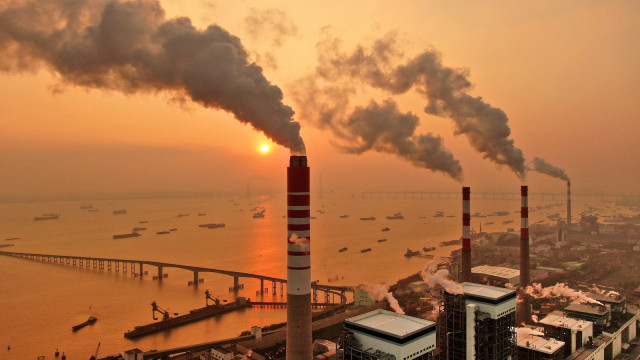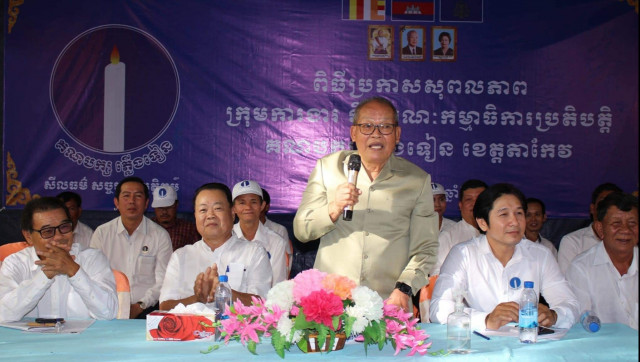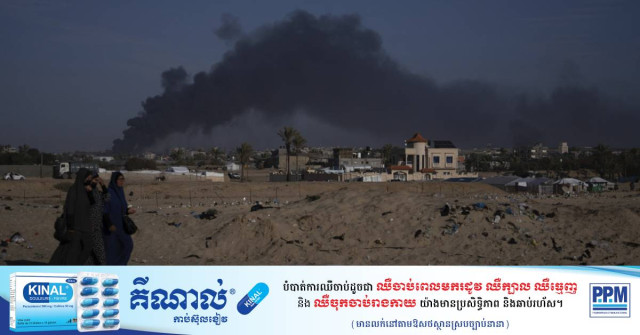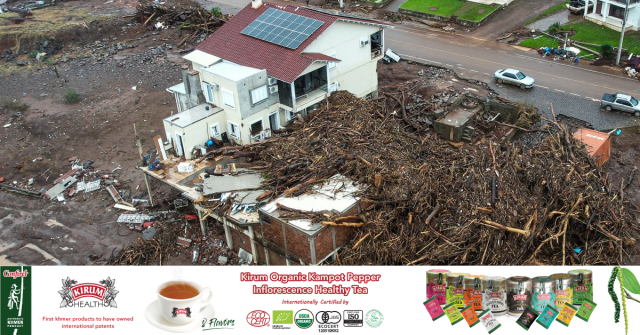Cambodia Pledges to End New Coal Projects as Climate Crisis Intensifies

- By Sao Phal Niseiy
- November 1, 2021 6:54 PM
The appetite for coal-fired power plants is waning worldwide and Cambodia is now adjusting its energy development course, but still aims to finish three planned coal projects
PHNOM PENH--Cambodia announced it will no longer invest in new coal-fired power as the global effort to reduce greenhouse gas emission as the 26th UN Climate Conference kicks off in Glasgow, the United Kingdom.
On Oct. 29, Minister of Mines and Energy Suy Sem reaffirmed the commitment to end new approval for coal-fired power plants during a meeting with UK Ambassador to Cambodia Tina Redshaw, adding that Cambodia would continue efforts to respond to the climate crisis and live up its pledges under the United Nations Framework Convention on Climate Change.
Cambodia has been largely reliant on fossil fuels for its growing energy demand, especially coal, which is one of the most polluting forms of power generation. Coal accounts for over 40 percent of the country’s current total energy production capacity, according to a 2019 report from the Ministry of Mines and Energy.
Sem also highlighted Cambodia’s partnership with the Asian Development Bank (ADB), which has prepared a new master plan for energy that will see renewables account for 59 percent of Cambodia’s total energy mix, which could reduce greenhouse gases by 34 percent by contrast to older energy development plans put forth by the government.
Ambassador Redshaw, in addition to welcoming Cambodia’s position on coal, said that she encouraged the government to consider terminating the planned projects too.
“We are encouraging Cambodia to state they will no longer accept any new coal power plants and urge them to reconsider those that have been planned but not built,” she said in an interview with Cambodianess.
“The business case for renewable energy is clear and the next generation of growing economies are already making the switch,” she added.
Han Phoumin, senior energy economist at the Economic Research Institute for ASEAN and East Asia, welcomed the government’s new position on coal projects.
“I fully support this decision to not add any more capacity in coal-fired power plants as an effort to reduce emissions and avoid the long-term impacts such as air pollution and climate change,” Phoumin said, adding that the pledge from Sem is very important to accelerate the transition towards lower carbon energy for Cambodia.
This comes as world leaders gather in Glasgow, Scotland for the 26th UN Climate Summit—known as COP26—where Cambodia’s Environment Minister Say Samal is expected to deliver a speech with further pledges to reduce carbon emissions.
One of the benchmarks for the COP26 summit success is new commitment to phase out coal power plants. Countries have been urged to discontinue financing and constructing coal power stations to reduce carbon emissions—the most prominent contributing factor to the climate crisis.
Growing Reluctance to Fund Coal Projects
Cambodia becomes one of the latest countries to promise not to further construct coal power stations as the pressure mounts on wealthy countries to live up to their promises. Even global financial institutions have declared an end to funding for coal power, forcing many developing countries to reposition their energy plans to transit away from coal power while seeking to direct more investment to clean energy.
In May 2021, the ADB also declared that it will no longer finance coal mining or oil and natural gas production and exploration, while the World Bank also increased finance for climate actions—including coal phaseout targets.
The most notable move is a pledge made in September 2021 by China, one of the largest investors in both coal and other forms of energy production throughout Southeast Asia, that saw President Xi Jinping signal that China would no longer finance coal projects abroad, although there remains some uncertainty as to how this announcement will play out in practice.
Currently, Cambodia has two operational coal power plants in Preah Sihanouk Province, and three others being constructed in Koh Kong, Oddar Meanchey and Preah Sihanouk provinces. More importantly, most of Cambodia’s coal financing has come from China.
Ham Oudam, an environmental analyst who advocates for solutions to environmental impacts driven by controversial hydropower and fossil fuel, noted that both China’s announcement to stop building new coal power plants and Cambodia’s latest decision are reassuring.
“It is a very positive development, as the negative impacts that coal can have on climate change and local communities are very clear,” Oudam said.
Rafael Guevara Señga, sustainable energy lead at WWF Cambodia, pointed out cheap public finance provided by countries like China, Japan, as well as South Korea, have over the past decades made developing countries like Cambodia more dependent on coal power.
“[The trend] has been fueled by the cheap public funds from China, Japan and South Korea,” Señga told Cambodianess in October 2021 during the annual Clean Energy Week festival, just days before Cambodia announced its commitment to halt coal power investment.
For Señga, the change of direction in financing from wealthier nations, will gradually embolden an alteration to energy plans in not only Cambodia, but also throughout Southeast Asia, where coal has been the chief provider of power for years.
“This will soon disappear because many countries, as well as G7 countries, have all committed to stopping financing coal in other countries. The flow of money will stop and it will prevent the construction of more coal power stations,” he stressed.
Cambodia Reluctant to Kick Coal?
For many developing countries in Southeast Asia including Cambodia, a decision to quit coal power appears to be difficult, despite both the environmental and health consequences of coal, along with the falling prices of renewables.
Señga of WWF pointed out that the continuing reliance coal plants is not driven by either technical or economic factors currently, but it is more related to political decisions taken by governments.
“The challenge is not technical or economic factor anymore but mainly is political,” he said, adding that it is associated with how decisions are made and what parameter and factors are considered in charting the development path ways of the country’s energy sector.
Another thing, Señga said, is the existing power systems as well as the technical capacity of the people in the power sector, not only Cambodia but also in other countries in the region, are designed for convention power systems with high based loads, coal and hydropower.
“There is also a resistance for change within the status quo because they’re used to the system and it is easy for them,” he added.
Oudam, concurred that the coal phaseout in Cambodia is a complex issue, noting that the government has been more comfortable with relying on traditional forms of energy generation.
“There are also powerful companies and individuals that benefit from large scale projects such as hydropower dams and coal plants, which may influence energy planning decisions,” Oudam said.
However, he stressed that the latest statement from Mines and Energy Minister Suy Sem can demonstrate a shift in political will, which will allow future decisions on energy transition to be made by taking into account both economic and environmental factors.
It is critical, Phoumin agreed, that certain levels of coal-generated power are retained for Cambodia’s development, but the country needs to find means of addressing emissions simultaneously.
“It still needs fossil fuels as well as [coal] power [projects] which are in operations, and these will be retired in 20-30 years in the future due to contracts,” he said, adding that preventing more coal plants is key now.
Practicalities of Shifting to Low Carbon Energy Sources
Diversifying energy sources remains one of Cambodia’s biggest challenges as the country tries to deal with a marked surge in energy demand driven by rapid development.
Energy Minister Sem said that the country will seek to invest in low-carbon energy sources such as LNG or hydrogen, as well as encourage more investment in clean energy such as solar.
Oudam observed that it is more crucial to center on investing in clean energy sources such as wind and solar as Cambodia has already been well-placed to transition to clean forms of energy.
“Obviously, Cambodia is very well positioned to expand its solar energy sector, and two wind power projects are under construction,” he said.
By focusing efforts on clean energy, he added, Cambodia can develop truly clean energy and also increase self-sufficiency and reduce reliance on fuel imports.
Meanwhile, Phoumin noticed that, despite the desirability of clean energy, the country also needs to ensure that this pursuit doesn’t result in high electricity prices for citizens. Therefore, he said, natural gas remains crucial for Cambodia in the energy transition periods.
In addition, he said Cambodia should also prepare to gradually embrace “green hydrogen” fuels produced from renewable sources as solar energy and hydro power.
“The curtailment of solar energy or hydro can be used for the battery storage or hydrogen fuel,” Phoumin said, adding that renewable hydrogen or green hydrogen could be an option for Cambodia as it can be used for power generation or fuel for transportation and other uses in the future.
Prime Minister Hun Sen, during the Taiyuan Energy Low-Carbon Development Forum 2021 on Sept. 3, said that Cambodia was eager to turn to low-carbon energy development, but added that needs to be done through the introduction “clean coal,” the controversial use of carbon-sequestering technology and hydrogen generated from coal commonly known as “brown hydrogen.”
“These [type of energies] will be necessary strategies to combat the climate crisis on a larger scale,” Hun Sen said.
Boosting Carbon Sequestration Efforts to Achieve Carbon Neutrality
Cambodia emits around 143 million metric tons of carbon dioxide from fossil fuels and cement production without including land use change, according to Our World in Data.
_1635778255.png)
In late 2020, the country also announced that it also was determined to establish a longstanding action plan in 2021 to realize carbon neutrality in line with its international obligations under the Paris Agreement.
The agreement aims to limit the rise of global temperature within 1.5 degree Celsius above the pre-industrial level by 2100 in order to save the world from climate catastrophe.
Despite the pledge, it still remains unclear when the government hopes to achieve carbon neutrality by and the process of preparing the action plan has yet to be completed.
When asked what Cambodia can do, in addition to ending coal, to ensure carbon emission reductions, Phoumin went on to suggest that the country also can also boost its capacity in carbon sequestration in the transportation sector, which continues to heavily depends on oil and diesel.
“Switching to electric vehicles and hydrogen cars should be planned,” Phoumin said.
Another solution, he added, could be for Cambodia to offset its greenhouse gases by promoting “reforestation” or introducing artificial carbon sink technology such as Carbon Capture Utilization and Storage (CCUS).
However, Phoumin emphasized that the new technology may be costly for developing countries like Cambodia.
“Thus, reforestation is a natural carbon sink and Cambodia may need to work on this way,” he said.

















